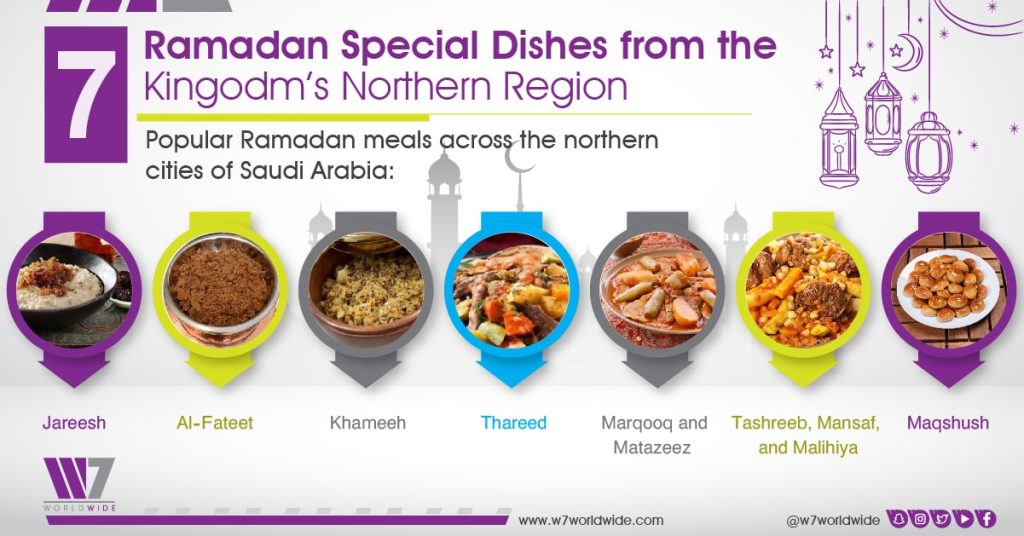Each of the Saudi regions offers its own delectable dishes and beverages that reflect its traditions and cultures and are especially relished during the holy month of Ramadan.
This year, W7Worldwide traveled to the northern region of Saudi Arabia to explore its Ramadan-special dishes. We spoke to residents in the region about their favorite Ramadan meals and found the following to be the most popular treats enjoyed by people during the holy month across the northern cities:
- Maqshush: Declared as the Kingdom’s national dessert, Maqshush is a must-try if you happen to be in the region. A “winter special” typically served for breakfasts, Maqshush is made of wheat flour, white flour, eggs, yeast, and milk. It is served topped with honey and ghee, and savored in Ramadan during iftar with tea or coffee.
- Tashreeb, Mansaf, and Malihiya. Almost similar in preparation, they are the staples of every Ramadan table in the northern region. Tashreeb is a succulent dish made of bread soaked in meat broth, with juicy pieces of meat. Mansaf, on the other hand, is prepared with mutton broth, milk and ghee. It is served with the shrak bread and rice, over which the meat is placed. Garnished with pine nuts, roasted almonds and chopped parsley, this traditional, rich dish is enjoyed across the Arab world as well. Meanwhile, Malihiya is very similar to Mansaf, with the only difference being that the former does not contain rice at all. It is cooked with meat and milk and is placed on plain bread. Cooked milk is poured with chopped meat on top of the bread. The Anza tribe in the north is famous for this dish.
- Marqooq and Matazeez. Popular in the Kingdom, Marqooq is a traditional dish, which comprises doughy flat dumplings cooked in a stew of meat, vegetables, and spices. It is cooked together until it becomes a broth. Flour and water are kneaded together to be added to the broth in stages until the broth dries. Matazeez is not much different except that the dough is smaller in shape, and nowadays may be readily available in the market.
- Thareed. It is a popular dish in which yogurt or milk is mixed with flour, water, and a pinch of salt. It is served with fresh dates and drizzled with honey and ghee. It is safe to say that no family gathering in Ramadan is complete without Thareed.
- Khameeh. A famous dish in the northern region, Jordan and Iraq, Khameeh is of two types: Khee’at Al-Milk, and Khee’at Al-bread and margarine (check the names, I did not find them online. How can one word be Arabic and another English? Khee’at Al-Milk? Al-bread?), which consists of wheat bread, milk, and sugar. It is prepared by mixing chopped bread with dates and kneaded together with ghee and milk.
- Al-Fateet. The star of the northern table is Fateet, a dessert made of wheat flour that is kneaded with sugar, ghee and cardamom, and then crumbled.
- Jareesh. The second official dish of Saudi Arabia, Jareesh (or Harees) is a dish of choice at most family gatherings, mainly during Ramadan. Jareesh is made with ground wheat cooked with rice, fried onions, vegetables, and chicken or meat. It is savored all across the Kingdom, with each region preparing its own version of the popular dish.
In addition to the above, people in the north are fond of modern dishes that are consumed alongside the more traditional Ramadan dishes. These include Raqash (small pieces of brown bread), Wafd, Mursa, Muflat, Madhan, Tasabi’, Masoub, and Haneeth.




